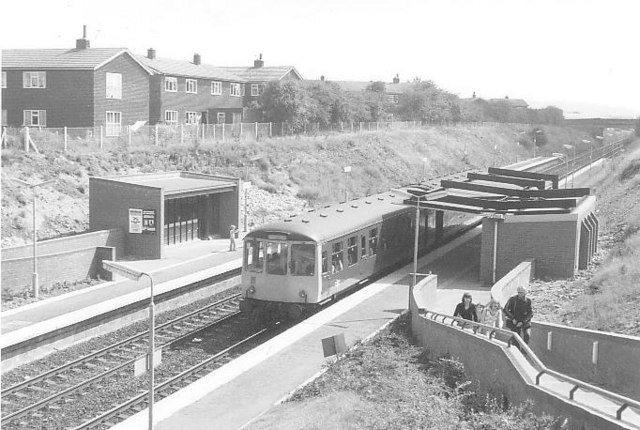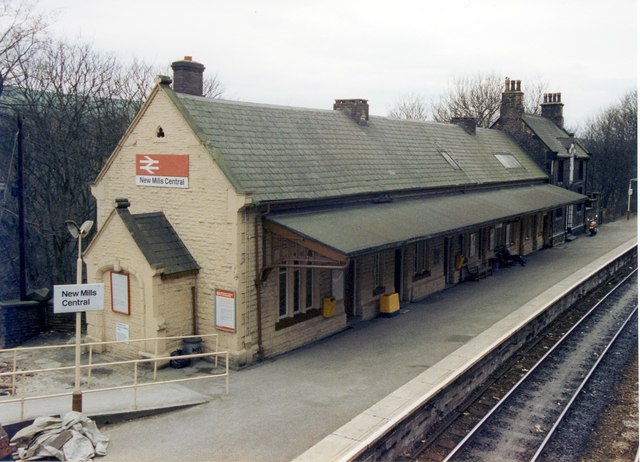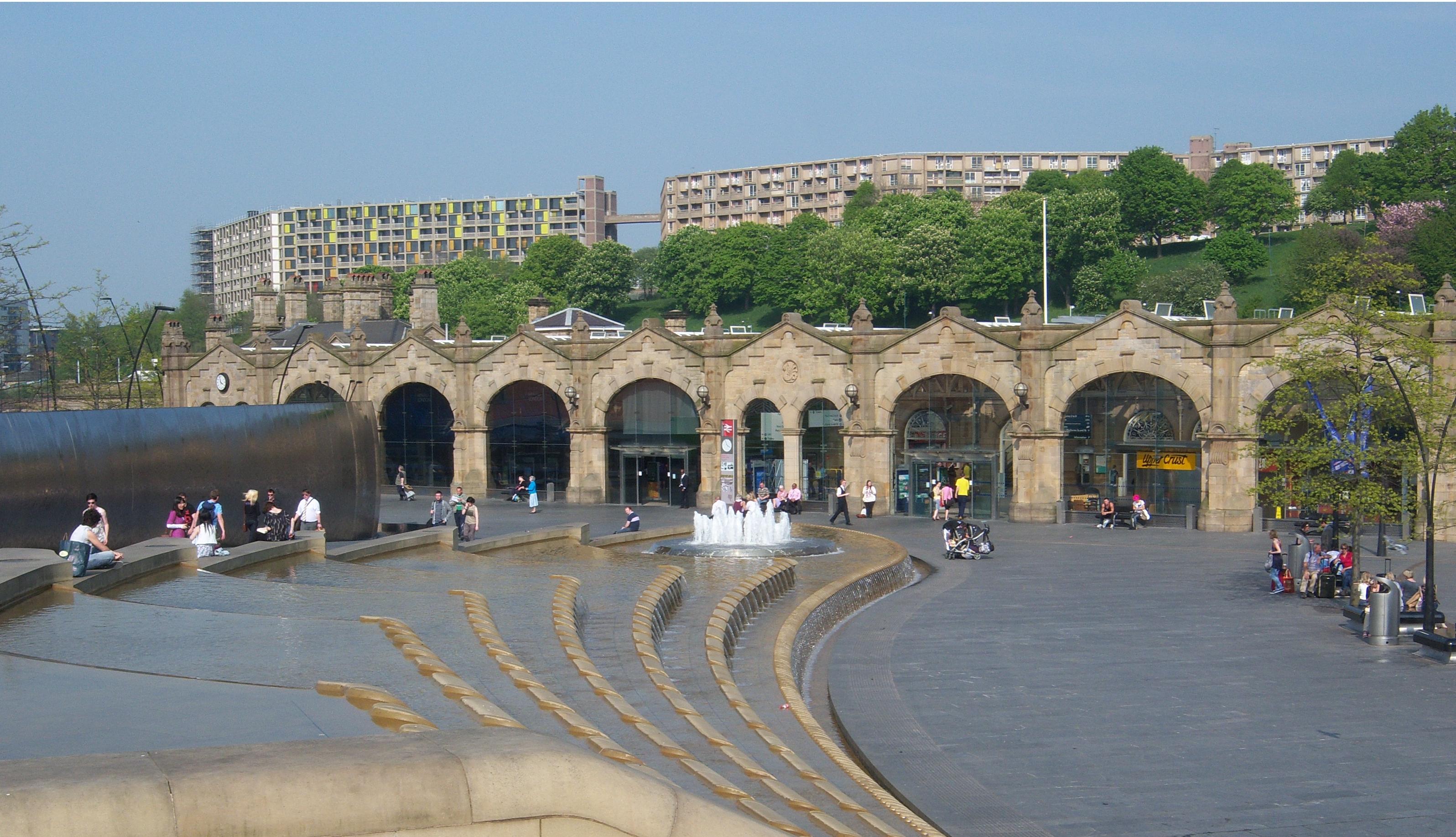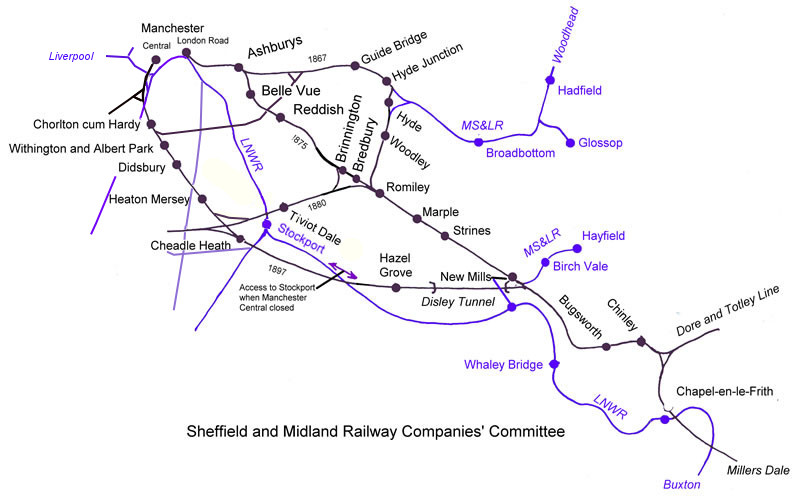|
Brinnington Railway Station
Brinnington railway station serves Brinnington in the eastern part of Stockport, Greater Manchester, England. It is a relatively new station, opening on 12 December 1977, by British Rail, on the line originally built by the Sheffield and Midland Railway Companies' Committee in 1875 between New Mills and Manchester London Road (now Piccadilly). Facilities The station has a staffed ticket office at street level, which is opened through the day on weekdays (06:30-20:50) and on Saturdays until early afternoon (07:20-14:25). Outside these times, tickets must be bought from the ticket machine or a promise to pay obtained. Platform-level amenities are limited to waiting shelters, timetable posters, digital CIS displays and bench seating. Automated train announcements are also provided. Access to the platforms is via footbridge and inclined ramps - these have steps, but can be negotiated by wheelchair users with assistance. [...More Info...] [...Related Items...] OR: [Wikipedia] [Google] [Baidu] |
Brinnington
Brinnington is a north-eastern suburb of Stockport, Greater Manchester, England, on a bluff above a bend in the Tame Valley between the M60 motorway and Reddish Vale Country Park. Description Brinnington was open farm land before the local authority housing developments of the 1950s and 1960s. To the west of Brinnington is Reddish Vale, a country park popular with families to go for a walk and explore the ponds and brick viaducts; under the arches there is a sharp bend in the river and sand has been deposited giving the effect of a miniature beach. The area consists mainly of council owned dwellings including high rise flats. Brinnington has high crime levels and long-term unemployment at 20%. Two streets, Northumberland Road and Brinnington Road, were named by police as two of the three worst roads in north Stockport in 2010. The area has undergone regeneration, including the demolition of the Top Shops site, replaced with 53 shared ownership houses, and First House communi ... [...More Info...] [...Related Items...] OR: [Wikipedia] [Google] [Baidu] |
New Mills Central Railway Station
New Mills Central railway station serves the town of New Mills in Derbyshire, England. It is on the Hope Valley Line between Manchester Piccadilly and Sheffield, east of the former. The town is also served by New Mills Newtown station, which is on the Buxton to Stockport and Manchester line. History In the mid-19th century, the Manchester, Buxton, Matlock and Midlands Junction Railway ran as far as Rowsley and was extended by the Midland Railway to Buxton, in its aim to run as far as Manchester. The Manchester, Sheffield & Lincolnshire Railway also wished to extend southwards from its main line through Woodhead Tunnel to Sheffield and had built a branch to Hyde. Meanwhile, the London and North Western Railway had constructed their own line to Buxton from Whaley Bridge, with a station at Newtown, which effectively blocked the other two. An agreement was reached whereby the MS&LR would build their proposed "Marple, New Mills and Hayfield Junction Railway", while the Midlan ... [...More Info...] [...Related Items...] OR: [Wikipedia] [Google] [Baidu] |
Railway Stations Opened By British Rail
Rail transport (also known as train transport) is a means of transport that transfers passengers and goods on wheeled vehicles running on rails, which are incorporated in tracks. In contrast to road transport, where the vehicles run on a prepared flat surface, rail vehicles (rolling stock) are directionally guided by the tracks on which they run. Tracks usually consist of steel rails, installed on sleepers (ties) set in ballast, on which the rolling stock, usually fitted with metal wheels, moves. Other variations are also possible, such as "slab track", in which the rails are fastened to a concrete foundation resting on a prepared subsurface. Rolling stock in a rail transport system generally encounters lower frictional resistance than rubber-tyred road vehicles, so passenger and freight cars (carriages and wagons) can be coupled into longer trains. The operation is carried out by a railway company, providing transport between train stations or freight customer facili ... [...More Info...] [...Related Items...] OR: [Wikipedia] [Google] [Baidu] |
DfT Category E Stations
The Department for Transport (DfT) is a department of His Majesty's Government responsible for the English transport network and a limited number of transport matters in Scotland, Wales and Northern Ireland that have not been devolved. The department is run by the Secretary of State for Transport, currently (since 25 October 2022) Mark Harper. The expenditure, administration and policy of the Department for Transport are scrutinised by the Transport Committee. History The Ministry of Transport was established by the Ministry of Transport Act 1919 which provided for the transfer to the new ministry of powers and duties of any government department in respect of railways, light railways, tramways, canals and inland waterways, roads, bridges and ferries, and vehicles and traffic thereon, harbours, docks and piers. In September 1919, all the powers of the Road Board, the Ministry of Health, and the Board of Trade in respect of transport, were transferred to the new ministry. ... [...More Info...] [...Related Items...] OR: [Wikipedia] [Google] [Baidu] |
Railway Stations In The Metropolitan Borough Of Stockport
Rail transport (also known as train transport) is a means of transport that transfers passengers and goods on wheeled vehicles running on rails, which are incorporated in tracks. In contrast to road transport, where the vehicles run on a prepared flat surface, rail vehicles (rolling stock) are directionally guided by the tracks on which they run. Tracks usually consist of steel rails, installed on sleepers (ties) set in ballast, on which the rolling stock, usually fitted with metal wheels, moves. Other variations are also possible, such as "slab track", in which the rails are fastened to a concrete foundation resting on a prepared subsurface. Rolling stock in a rail transport system generally encounters lower frictional resistance than rubber-tyred road vehicles, so passenger and freight cars (carriages and wagons) can be coupled into longer trains. The operation is carried out by a railway company, providing transport between train stations or freight customer facilit ... [...More Info...] [...Related Items...] OR: [Wikipedia] [Google] [Baidu] |
Sheffield Railway Station
Sheffield station, formerly ''Pond Street'' and later ''Sheffield Midland'', is a combined railway station and tram stop in Sheffield, England; it is the busiest station in South Yorkshire. Adjacent is Sheffield station/Sheffield Hallam University Sheffield Supertram stop. In 2017–18, the station was the 43rd-busiest in the UK and the 15th-busiest outside London. History 1870 - 1960 The station was opened in 1870 by the Midland Railway to the designs of the company architect John Holloway Sanders. It was the fifth and last station to be built in Sheffield city centre. The station was built on the 'New Line', which ran between Grimesthorpe Junction, on the former Sheffield and Rotherham Railway, and Tapton Junction, just north of Chesterfield. This line replaced the Midland Railway's previous route, the 'old road', to London, which ran from Sheffield Wicker via Rotherham. The new line and station were built despite some controversy and opposition locally. The Duke of Norf ... [...More Info...] [...Related Items...] OR: [Wikipedia] [Google] [Baidu] |
Marple Railway Station
Marple railway station is on the Hope Valley Line and serves Marple, in the Metropolitan Borough of Stockport, Greater Manchester, England. It is south-east of Manchester Piccadilly. The station, opened in 1865 by the Manchester, Sheffield and Lincolnshire Railway, was demolished and rebuilt in 1970. It is managed and served by Northern Trains, who provide two trains per hour in each direction. The other station in Marple is Rose Hill Marple, on a spur of the Hope Valley Line which, until 1970, continued towards Macclesfield. Description The station is to the east of Marple, near Marple Bridge and close to Brabyns Park and the Peak Forest Canal. The A626 runs over a bridge next to the station and provides access to it. The next station towards Piccadilly is Romiley and the next towards Sheffield is Strines. The station has two side platforms, each long; platform 1 can only be reached by a footbridge (with lifts) over the tracks and platform 2 can be accessed from the tick ... [...More Info...] [...Related Items...] OR: [Wikipedia] [Google] [Baidu] |
Diesel Multiple Unit
A diesel multiple unit or DMU is a multiple-unit train powered by on-board diesel engines. A DMU requires no separate locomotive, as the engines are incorporated into one or more of the carriages. Diesel-powered single-unit railcars are also generally classed as DMUs. Diesel-powered units may be further classified by their transmission type: diesel–mechanical DMMU, diesel–hydraulic DHMU, or diesel–electric DEMU. Design The diesel engine may be located above the frame in an engine bay or under the floor. Driving controls can be at both ends, on one end, or in a separate car. Types by transmission DMUs are usually classified by the method of transmitting motive power to their wheels. Diesel–mechanical In a diesel–mechanical multiple unit (DMMU), the rotating energy of the engine is transmitted via a gearbox and driveshaft directly to the wheels of the train, like a car. The transmissions can be shifted manually by the driver, as in the great majority of first-gen ... [...More Info...] [...Related Items...] OR: [Wikipedia] [Google] [Baidu] |
Manchester Piccadilly Railway Station
Manchester Piccadilly is the principal railway station in Manchester, England. Opened as Store Street in 1842, it was renamed Manchester London Road in 1847 and became Manchester Piccadilly in 1960. Located to the south-east of Manchester city centre, it hosts long-distance intercity and cross-country services to national destinations including Euston railway station, London, Birmingham New Street railway station, Birmingham, Nottingham station, Nottingham, Glasgow Central station, Glasgow, Edinburgh Waverley station, Edinburgh, Cardiff Central railway station, Cardiff, Bristol Temple Meads railway station, Bristol, Exeter St Davids railway station, Exeter, Plymouth railway station, Plymouth, Reading railway station, Reading, Southampton Central railway station, Southampton and Bournemouth railway station, Bournemouth; regional services to destinations in Northern England including Liverpool Lime Street railway station, Liverpool, Leeds railway station, Leeds, Sheffield railway s ... [...More Info...] [...Related Items...] OR: [Wikipedia] [Google] [Baidu] |
Sheffield And Midland Railway Companies' Committee
The Sheffield and Midland Railway Companies' Committee was incorporated by Act of Parliament in 1869 as a joint venture between the Midland Railway and the Manchester, Sheffield and Lincolnshire Railway. Origins For many years the Midland had been wishing to extend its line from London St.Pancras to Manchester, via Derby and the Manchester, Buxton, Matlock and Midlands Junction Railway. It was thwarted by the London and North Western Railway which already had a line from Manchester to London, via Birmingham and had built a branch line to Buxton. Meanwhile, The Great Northern Railway was also averse to more competition in the area, and the MS&LR wished to expand southwards from its main line from Manchester, via Penistone, to Sheffield. The three joined forces in a series of tripartite agreements, which not being sanctioned by Parliament, were of doubtful legality. However James Allport, with some other Midland directors, met some members of the MS&L board while surveying the ... [...More Info...] [...Related Items...] OR: [Wikipedia] [Google] [Baidu] |
Metropolitan Borough Of Stockport
The Metropolitan Borough of Stockport is a metropolitan borough of Greater Manchester in North West England, south-east of central Manchester. As well as the towns of Stockport, Bredbury and Marple, it includes the outlying areas of Hazel Grove, Bramhall, Cheadle, Cheadle Hulme, Gatley, Reddish, Woodley and Romiley. In 2021, it had a population of 294,800. The borough is third-most populous of Greater Manchester. History The borough was created in 1974, under the Local Government Act 1972, from the former area of the County Borough of Stockport and from the administrative county of Cheshire the urban districts of Bredbury and Romiley, Cheadle and Gatley, Hazel Grove and Bramhall and Marple. Stockport became a county borough in 1889 and was enlarged by gaining territory from Lancashire, including Reddish in 1906 and the Four Heatons in 1913. The Marple Urban District of Cheshire, formed in 1894, gained parts of Derbyshire in 1936 including Mellor and Ludworth from Chapel e ... [...More Info...] [...Related Items...] OR: [Wikipedia] [Google] [Baidu] |




.jpg)

